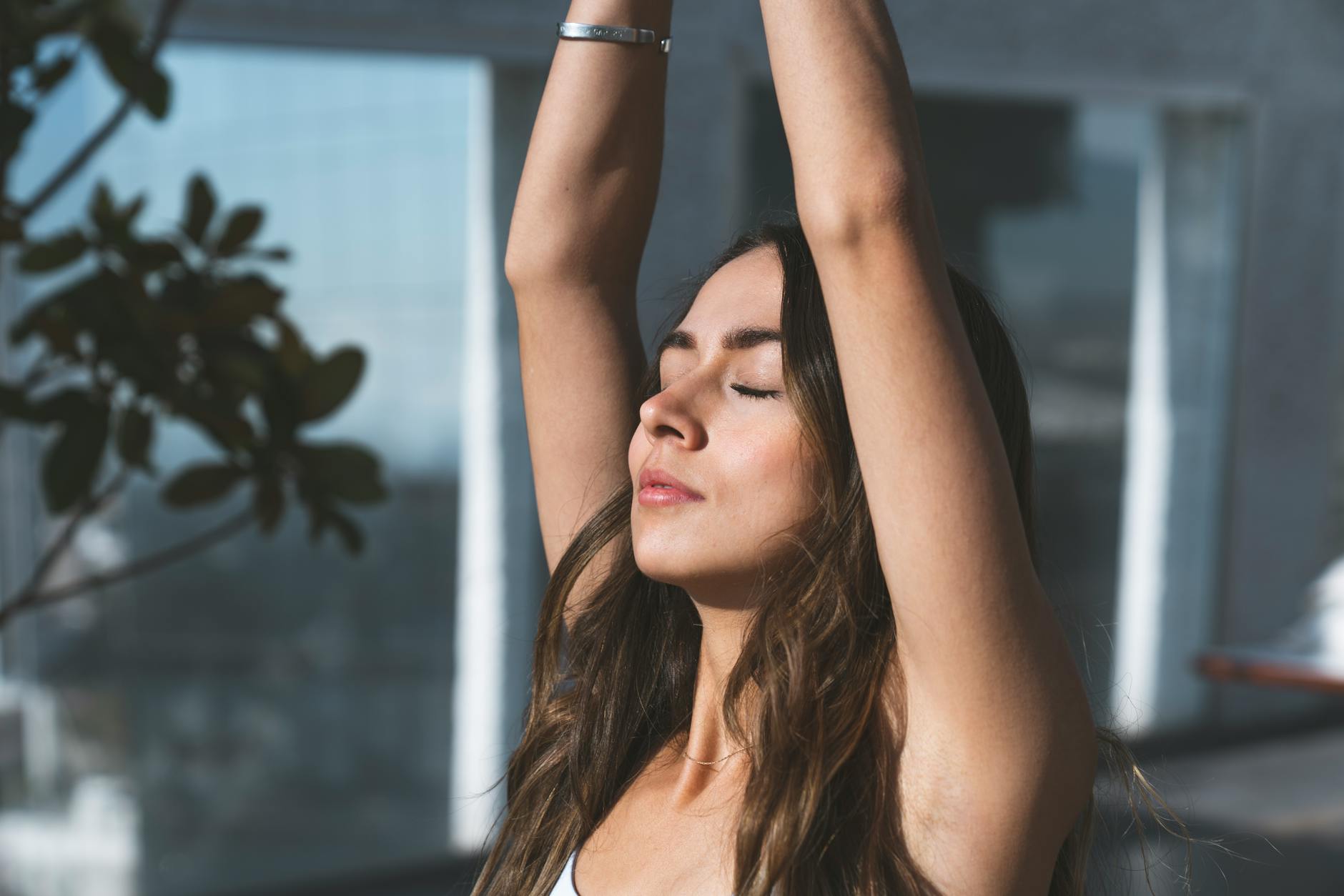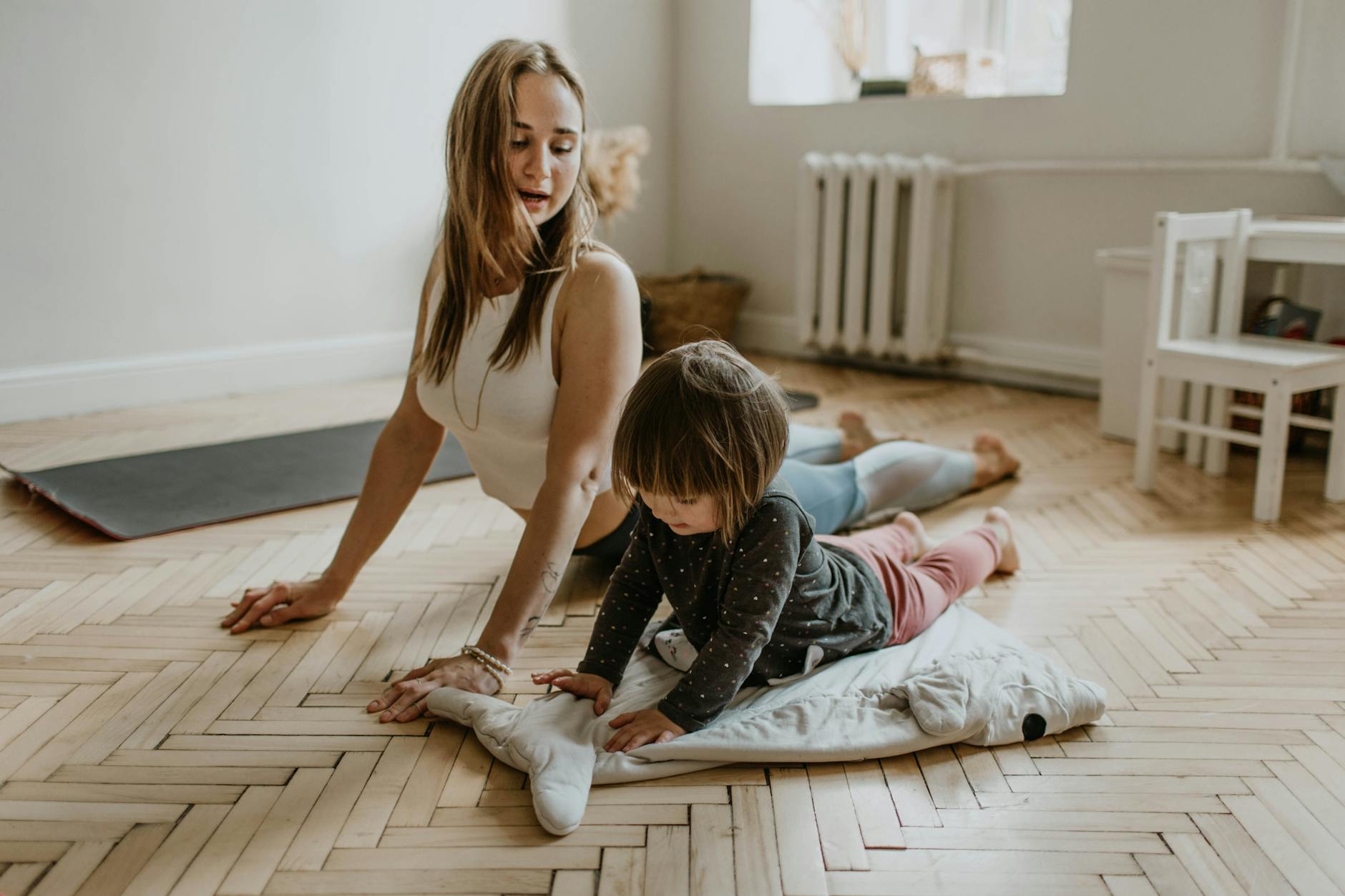No products in the cart.
No products in the cart.
Anxiety and stress aren’t just occasional visitors anymore—they’ve practically moved in for many of us. If you’ve been feeling like your brain’s stuck in overdrive, you’re not alone. The good news? Yoga might be the reset button your mind and body need. By combining gentle movement, mindful breathing, and moments of stillness, yoga works to calm an overactive nervous system. Whether you’re looking to loosen tense muscles, quiet racing thoughts, or just take a break from the chaos, this practice offers a natural and powerful way to feel more centred. Ready to feel a little lighter? Let’s get into it.
Stress and anxiety are more than just fleeting emotions—they’re physiological and psychological phenomena that leave their marks on your body and mind. Understanding how these work can help you take the first step toward managing them. Let’s break it down.
When stress or anxiety strikes, your body flips into survival mode. This fight-or-flight response is controlled by your nervous system and is designed to protect you in truly dangerous situations. But in today’s world, where email alerts and societal pressure can trigger the same reaction, it can quickly become overwhelming.
Here’s what happens during the fight-or-flight response:
These changes can be lifesaving in emergencies, but when activated too often, they wreak havoc. Chronic activation can lead to muscle tension, headaches, irritability, and even a weakened immune system. Your brain’s productivity can also take a nosedive, affecting memory and concentration. Learn more about how stress impacts your nervous system in this detailed article on Stress and the Nervous System.
So, why do traditional approaches like medication and therapy sometimes fall short? They’re valuable, but they don’t always address the root causes of stress and anxiety. This is where holistic practices like yoga come into play. Instead of just putting a bandage on the symptoms, they aim to restore balance to your entire body.
Research shows that combining traditional treatments with practices like yoga can amplify results. Even Harvard Health highlights that integrating holistic approaches offers long-term benefits for managing stress and anxiety. Check out more about alternative and holistic anxiety management on Holistic Approaches to Anxiety.

Photo by Mikhail Nilov
Yoga is not just another form of exercise—it’s a lifestyle shift that meets you where you are. It doesn’t matter if you’re a complete newbie or someone who’s always thought touching your toes was impossible. Everyone benefits from a practice designed to care for both mind and body.
Yoga is widely recognized as a powerful tool to combat the pressures of modern life. By combining breathwork, mindful movement, and gentle postures, yoga offers more than just flexibility; it provides a sanctuary for calming the mind and soothing the body. Let’s dive into how yoga achieves this.
One of yoga’s standout features is its focus on controlled breathing or pranayama. For individuals struggling with anxiety, breathing can often become shallow or erratic. Pranayama helps reverse this by encouraging slow, deliberate breaths, which act like hitting a “reset button” for the nervous system.
Take the Ujjayi breath, for example, also known as the “victorious breath.” This technique involves breathing deeply through the nose and slightly constricting the throat on the exhale, creating a sound reminiscent of ocean waves. Not only does this breathing steady your heart rate, but it also fosters a deep sense of calm.
If you’re interested in learning more about effective breathing techniques, 6 Yoga Breathing Exercises for Stress and Anxiety by Today provides step-by-step guidance.
Yoga seamlessly links movement with breath. This synchronization is what makes it so effective for stress relief. Think about it as a way of bridging the gap between mind and body—like syncing up headphones to your favourite playlist.
When you engage in mindful movement, your focus shifts away from racing thoughts to the here and now. It’s hard to be caught in a loop of worry when your attention is on transitioning from one pose to another. For example, flowing from Downward Dog to Warrior I while maintaining steady breathing can create a rhythm that soothes mental agitation.
Further, mindful movement cultivates body awareness, which helps in identifying and releasing tension you might not even realize you’re holding in your shoulders, jaw, or hips. For key insights into how mindful movement benefits your mental health, check out Mindful Movement: How It’s Done and Why It’s Good for You.

Photo by cottonbro studio
Yoga’s calming effects aren’t just about what’s in your head—they’re rooted in your biology. When you’re stressed, your sympathetic nervous system (think fight-or-flight mode) dominates. Yoga, however, helps activate the parasympathetic nervous system, also known as the “rest-and-digest” mode.
Through specific poses, prolonged exhales, and gentle stretches, yoga allows your body to switch from survival mode to a state of relaxation. For instance, the simple Child’s Pose calms the mind while gently stretching the spine, signalling your body to release tension.
Ever heard of the vagus nerve? It’s the command centre for your parasympathetic system, and yoga is known to stimulate it. Practices like diaphragmatic breathing and poses such as Supta Baddha Konasana (Reclining Bound Angle) tap into this nerve, helping reduce cortisol levels. Curious about this process? Learn more through How Yoga Calms the Nervous System by Heart & Bones Yoga.
Yoga doesn’t just help you feel calmer—it teaches your body a new, healthier response to persistent stress.
Yoga offers a natural way to manage anxiety and stress, combining movement, breathwork, and mindfulness. Different poses target specific physical and emotional needs, allowing you to centre your mind, restore balance, and release tension. Whether you aim to ground yourself, find inner calmness, or energize, there’s a pose that aligns with your goals. Let’s break down how specific yoga poses can become your toolkit for navigating life’s stressors.
Seated poses are unmatched when it comes to anchoring your mind and body. They help you pause and reconnect, offering a gentle release of tension.
Both poses are fantastic for grounding yourself when anxiety feels overwhelming. For a deeper look into why grounding poses are so effective, check out this overview on Yoga Poses for Anxiety.
Standing poses engage your entire body, fostering strength, stability, and a focused mind. These are ideal not just for physical balance but for creating emotional stability.
Standing poses remind us that finding balance isn’t just about physical alignment; sometimes, it’s about mental clarity too.
Sometimes, you just need to let go. Restorative poses allow your body to relax deeply, signalling your brain to quiet down and unwind.
For deep relaxation, these poses encourage your parasympathetic nervous system to take over. Curious about their magic? Read more about Yoga for Relaxation.

Photo by Los Muertos Crew
Forward folds encourage introspection by gently stretching the spine and calming the nervous system. They’re like giving your brain a warm hug.
Forward bends help shift your focus inward, providing a mental timeout when life gets overwhelming.
Heart-opening poses aren’t just great for your chest—they’re emotional game-changers. These poses can help you breathe deeply, work through emotional tension, and reset your mood.
Heart-opening poses remind us that sometimes the best way to feel better is to physically open up, allowing energy and joy to flow freely. Learn more about their benefits in this Yoga Guide.
Whether you’re grounding, balancing, or opening your heart, these poses serve as a reminder that your body holds the key to calm. By weaving yoga into your day-to-day, you’re not just managing stress—you’re transforming how you approach life.
When it comes to managing anxiety and stress through yoga, consistency isn’t just helpful—it’s essential. A steady practice builds a foundation for long-term benefits. Yoga doesn’t work overnight, but with regular effort, it becomes a tool you can rely on for calm and balance when life feels chaotic.
Consistency can feel daunting, especially when life is already hectic. But here’s the secret: start small. Think of yoga-like building a campfire; you don’t dump a whole tree onto the flames. Instead, you add a little kindling, and some wood, and gradually the fire grows.
Avoid aiming for perfection. Life happens, and it’s fine to miss a day. The key is consistency over time, not rigid discipline. For inspiration on sticking to a yoga schedule without getting overwhelmed, check out Consistency in Practice.

Photo by Valeria Ushakova
Tracking your yoga journey can be incredibly motivating—and it’s simpler than you might think. A yoga journal isn’t just a notebook; it’s like a mirror showing how far you’ve come.
Here’s how to do it:
Writing regularly keeps you engaged and aware of yoga’s impact on your mind and body. Not into journaling? Even quick notes on your phone can do the trick! For more ideas on creating your own yoga journal, dive into Why You Should Keep a Yoga Journal.
Regularly looking back on your entries provides proof of your growth, which can be the motivation you need to keep going. Small wins, like letting go of tension in your shoulders, add up over time to create lasting change.
Anxiety isn’t just a mental state—it’s a full-body experience. When daily stressors pile up, yoga can provide the mental and physical grounding needed to regain balance. But what does the science say? Let’s explore.
The conversation around yoga’s effectiveness for anxiety management has moved beyond anecdotal evidence. Studies now highlight significant outcomes, especially for those with Generalized Anxiety Disorder (GAD).
A clinical trial published in JAMA Psychiatry compared Kundalini Yoga, Cognitive Behavioral Therapy (CBT), and stress education. Results showed that while CBT remains the go-to for treating GAD, yoga stood out as a viable alternative. Participants practising Kundalini Yoga saw substantial reductions in anxiety symptoms over a 12-week period. Read more about this comparison here.
Similarly, a study conducted by researchers at NYU Langone Health revealed that yoga was significantly more effective in reducing anxiety symptoms compared to standard stress management education. This adds weight to the idea that when it comes to anxiety, yoga holds its ground as a complementary therapy. Learn more about their findings at NYU Langone Health.
Why does this matter? Yoga isn’t just “stretching.” It’s structured mindfulness combined with intentional movement, offering the same benefits as mental strategies used in CBT, but with added physical perks.
Yoga is often seen as a quick fix: 15 minutes of peace before diving back into chaos. But what happens when yoga becomes a regular practice? Studies suggest the effects go far beyond fleeting serenity.
Research from Harvard Health Publishing emphasizes yoga’s role in reducing both anxiety and depression over time. The consistent practice appears to rebuild the brain’s ability to handle stress by strengthening connections in emotional control centres. This isn’t just about feeling momentarily better—this is about creating a long-term shift in how we mentally process daily challenges. Check out more insights at Harvard Health’s report on yoga and mental health.
Furthermore, a study from The Beckman Institute showed how moderate-intensity yoga practised at home significantly reduced stress and anxiety levels for full-time workers. Participants also reported improved short-term memory and emotional resilience. It’s not just about calming your nerves—it’s about sharpening your mind. More details can be found in this study from Beckman Institute.
This lasting impact makes yoga more than a quick fix—it’s a sustainable strategy for keeping mental health on track.
Not all yoga practices are created equal, and that’s a good thing. Anxiety affects people in different ways, which means the one-size-fits-all solution simply doesn’t work. Instead, yoga thrives because of its adaptability.
Hatha yoga may suit beginners who want slow-paced sequences that target mindfulness and flexibility gently. Meanwhile, Vinyasa flow, a more fluid style, may better serve those who need to channel nervous energy.
Are you someone battling racing thoughts at bedtime? Restorative yoga, filled with poses like Supta Baddha Konasana, encourages the ultimate unwind. On the flip side, those dealing with morning anxiety may benefit from energy-boosting sequences focused on Sun Salutations.
Tailoring a yoga practice to individual needs transforms it from “just another workout” into a targeted wellness strategy. Remember, even minor adjustments like intensity or focus on breathwork can bring noticeable differences.

Photo by Mikhail Nilov
The flexibility and personalization of yoga make it uniquely effective for creating lasting mental clarity and peace in a world filled with constant noise.
Yoga can be a powerful tool for managing anxiety and stress, but it’s not a one-size-fits-all solution. Before integrating yoga into your routine, it’s crucial to consider certain limitations and situations where professional help might be necessary. Let’s unpack this further.
Yoga is helpful, but there are times when it may not be enough. Think of yoga like a supportive friend—it can’t replace a skilled doctor or therapist when the situation demands medical intervention.
For instance:
Yoga can complement—but not replace—specialized treatments for severe conditions. Not sure where yoga fits into your journey? A therapist or healthcare professional can guide you. To learn more about the potential contraindications of yoga for mental health, visit How Does Yoga Reduce Anxiety?.

Photo by Ketut Subiyanto
Yoga doesn’t have to go solo—it plays well with other forms of treatment. Think of it as a team player on your road to healing. For those under a healthcare provider’s care, integrating yoga can complement therapy, medication, or other treatments.
Here’s why this combo works:
For example, pairing yoga with anxiety medications such as SSRIs can amplify the combined benefits, helping manage nervous system responses and promoting calmness. Find out more about this approach from Yoga Therapy Can Help Ease Anxiety and Depression.
Consulting with a medical professional ensures you’re building a safe and effective mental health toolkit. Personalizing your approach might just turn the chaos in your mind into a map toward clarity.
Yoga offers an accessible yet transformative way to navigate the challenges of anxiety and stress. Combining mindful movement, breathing techniques, and restorative poses, it calms the nervous system and fosters emotional balance.
The simplicity of yoga makes it suitable for beginners, while the depth of the practice allows for lifelong growth. Whether it’s a 5-minute breathing exercise or an hour-long flow, every step counts toward better mental health.
Why not unroll your mat and start today? Your mind—and body—will thank you.
If you want or need assistance with this article, please don’t hesitate to Contact Us
Karen Blake
BAHN-NLP
TFT-DX



